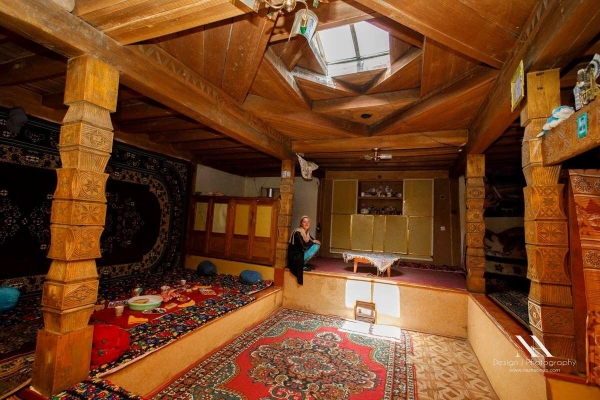
In the rugged lunar landscapes of the Pamir Mountains, people have long carved out a vibrant cultural world in stark contrast to their severe natural environment. Their traditions include striking music and dance, colorful celebrations, ancient rituals, and remarkably preserved languages—relics that vanished from the Central Asian lowlands over a thousand years ago. Among their most unique achievements is the architecture of the Pamiri house – “chid”, an indigenous creation that holds great value for historians, architects, and cultural preservationists.
Until the mid-1950s, due to the natural isolation of high-altitude valleys, Pamiri homes remained largely untouched by external influences. Expeditions in the 1970s were still able to study the architectural, structural, and decorative characteristics of these houses, tracing their historical roots.
Research across the wider region known as the “Pamir-Hindu Kush Ethnolinguistic Area”—spanning Afghanistan, Pakistan, India, and China—confirmed the enduring presence of a unique type of traditional hall-like dwelling. Known for its stepped wooden ceiling structure, or "chorkhona," and a central smoke and light opening, the "röz," this type of home represents one of the oldest surviving domestic architectural forms.
Archaeological evidence suggests such homes were once widespread across ancient and medieval Central Asia and other parts of Eurasia. Over centuries of practical refinement, the Pamiri house evolved to suit the extreme mountain climate, seismic activity, and the lifestyle of extended patriarchal families.
The symbolism and spiritual traditions associated with the house—including a rich cosmology and specific terminology—support the view that it is both a physical structure and a cultural artifact. As a result, many experts advocate for the inclusion of the Pamiri house in UNESCO’s Representative List of the Intangible Cultural Heritage of Humanity.
Inside the Pamiri house: a living cultural code
The traditional Pamiri house—called "chid"—remains the main residential structure for several Pamiri ethnic groups, including the Shugnans, Rushans, Wakhis, Ishkashimis, Vanjis, Yazgulamis, and Sarikolis. Among master builders, there is a saying: "seven doors under one roof," reflecting the house’s function as a complex of interconnected living and utility spaces.
At its heart is a large, enclosed square room—chid—up to 10 meters wide and 5 meters high, with a central hearth and a light/smoke vent, the röz. This space traditionally hosted extended families and formed the centerpiece of domestic life.
The layout follows a seasonal logic. Entering from outside, the sequence includes: pehvoz – a summer porch with open columns; darundalidz – a vestibule used in spring and autumn; and chid – the main, fully enclosed winter room.
This spatial organization allowed different parts of the house to be used depending on the season. The chid, because of its multifunctionality, was built with careful planning and a near-canonical internal layout—a sign of centuries of evolution.
Researchers compare the Pamiri house to Noah’s Ark—a self-contained world equipped with everything needed for life. The house's wide, elevated clay platforms ("suf" or "nekh") serve multiple roles—from sitting and sleeping areas to social spaces. These platforms are often segmented by low partitions—either earthen ("mundal") or wooden ("tahtabande")—each area serving a specific function.
Opposite the hearth lies the “barnekh”, which was intended for guests, while the "vogznekh" directly faces the entrance and is reserved for ceremonial occasions such as weddings—where the bride and groom are seated. The five central wooden pillars ("sitan") support the chorkhona, a stepped ceiling of four concentric square frames stacked diagonally, ending in the röz at the top.
This clever ceiling design not only distributes weight efficiently during earthquakes but also improves smoke ventilation and natural lighting. The two front columns, referred to as the "welcoming pillars," are connected by a carved crossbeam called "buchkigich".
Directly inside the entrance stands the main central pillar—"hasitan", the symbolic heart of the home. Beneath the skylight, a drainage pit ("obhin") absorbs water and is covered with a stone disk featuring a hole.
This entire structure is a carefully balanced seismic-resistant framework, capable of withstanding earthquakes of up to 9 on the Richter scale.
Form, function, and spiritual symbolism
The spacious chid serves more than just domestic purposes. During festivals and ceremonies, it transforms into a community theater. Guests are seated according to social hierarchy on the elevated sufs, while the sunken central area, "poiga", becomes a stage for dances, rituals, and pantomime.
The design of the Pamiri house varies with altitude. In lower valleys (around 1,700 meters), homes may include separate structures. But in upper regions (up to 3,500 meters), houses become compact and integrated complexes, adapted to harsher climates. The architecture maintains warmth in winter and coolness in summer, thanks to the compact design and strategic use of materials.
The "pehvoz", an open colonnaded porch, breaks the visual monotony of the otherwise enclosed chid, acting as a symbolic and physical invitation into the home. Visitors enter through the courtyard ("dargo"), pass beneath the pehvoz, through the vestibule (darundalidz), and finally into the light-filled chid, where a beam of sunlight illuminates the center space—filling the home with a sense of epic dignity. The five-pillar version of the Pamiri house is the most common, and its construction is a deeply communal event. Villagers gather to assist, "kiryar", and the process unfolds in three ritualized stages, accompanied by feasts and spiritual ceremonies.
Artistry in wood: a symbolic language
Pamiri craftsmanship is most evident in the intricate woodwork that adorns the house. From carved cornices and beam ends on the pehvoz, to the ornate columns and cabinets within the chid, the artistry is both decorative and symbolic.
Particular attention is given to the "buchkigich", a horizontal carved plank unique to Upper Badakhshan. Often the only decorative element in modest homes, it symbolizes hospitality and abundance. The designs incorporate solar (Khir) and lunar (Mest) motifs—believed to represent agricultural cycles.
The most common woodcarving styles include geometric patterns: multi-rayed rosettes, diamonds, squares, crosses, and swastikas, all echoing ancient spiritual and cosmological beliefs.
The Pamiri house is more than architecture—it is a physical expression of a people’s resilience, artistry, and cosmology. A carefully engineered structure with symbolic richness and adaptive design, it justly earns its comparison to Noah’s Ark—a vessel carrying the essentials of life, spirit, and identity across generations.




